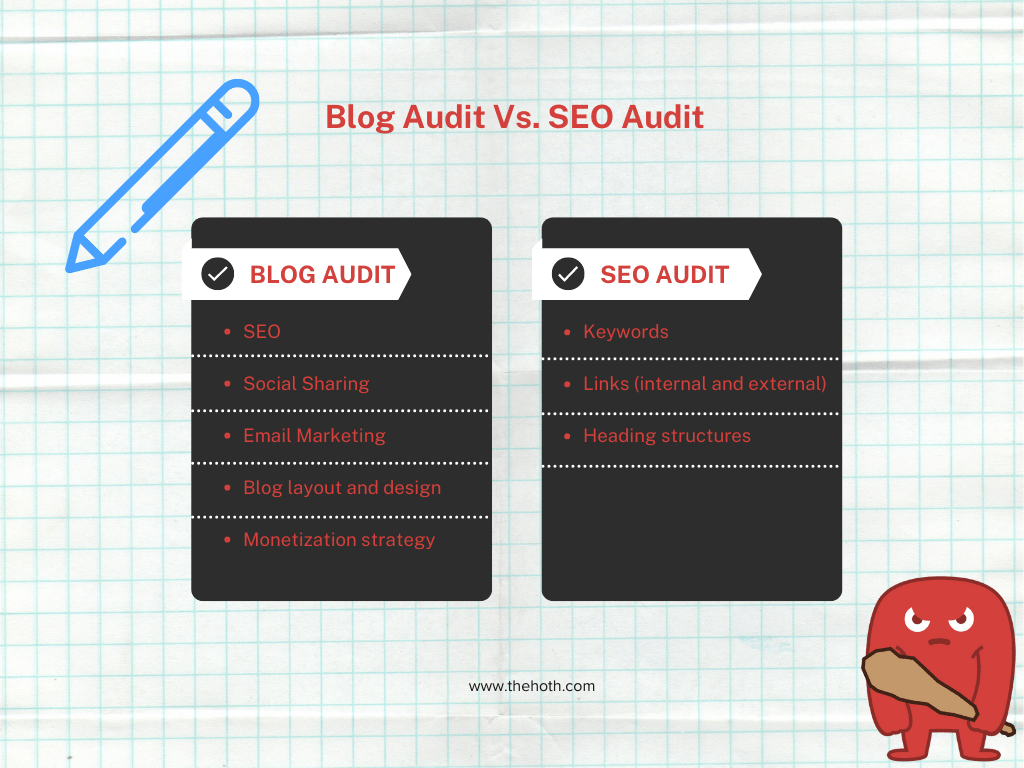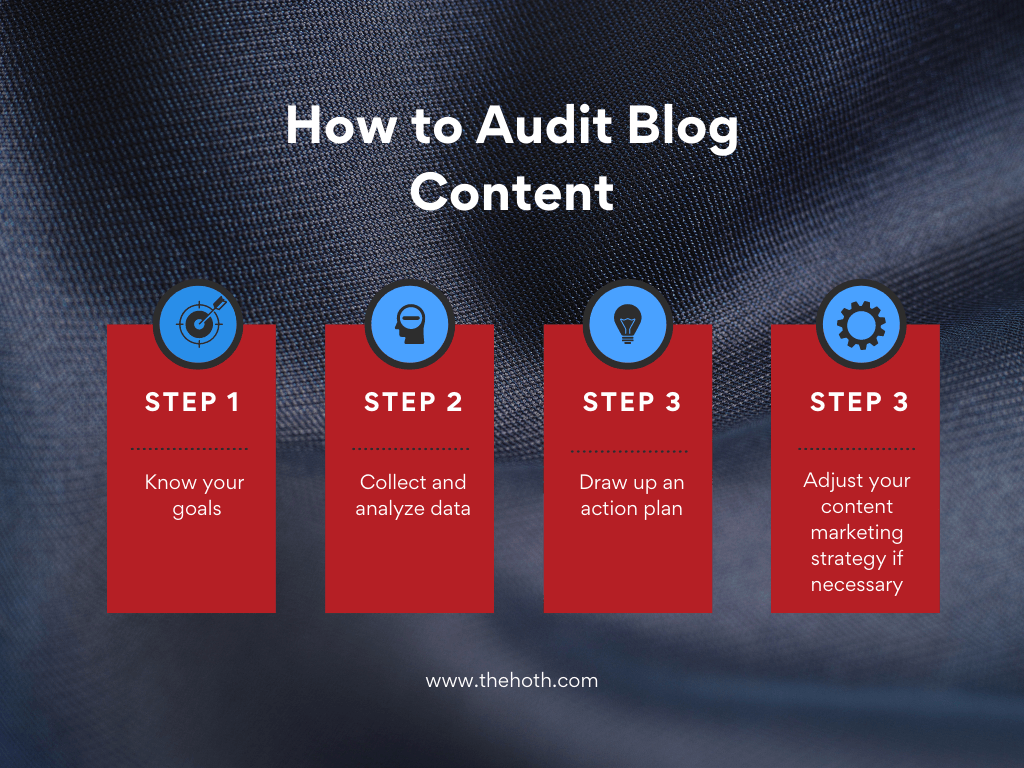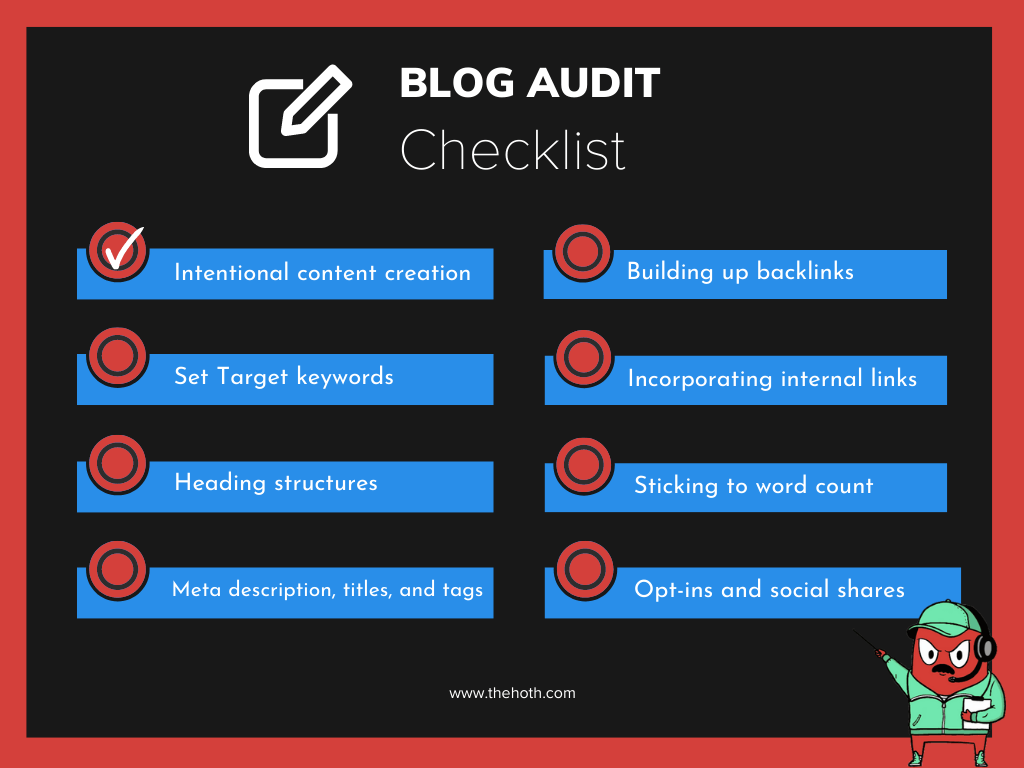Quick Links
It is absolutely vital to take time to assess pre-existing blog content.
In fact, according to the Content Marketing Institute, 80% of marketing content goes unused by sales teams because it’s irrelevant or hard to find.
Below, we’ll cover how you can conduct a blog audit, how to make your content audits more effective, and the best practices for SEO audits.
Ready to send your content straight into your readers’ search results?
Keep scrolling!
What Are the Differences Between a Blog Audit, Content Audit, and an SEO Audit?
Audits are an important part of checking in on the success of your page SEO, blogs, and overall content marketing strategy.
You can run an audit on your entire website, on specific landing pages, on your own blogs, and much more.
Blog audits focus on the quality and relevancy of your content.
Additionally, a blog audit is a complete review of your blog.
It is a comprehensive check of:
- SEO
- Social sharing
- Email marketing
- Blog layout and design
- Monetization strategy
Whereas a search engine optimization (SEO) audit focuses on technical features of your website, such as your use of:
- Keywords
- Links (internal and external)
- Heading structures
Finally, a content audit catalogs and analyzes the content on your blog or website including its performance metrics.
The Importance of SEO Blog Audits
Content audits look at how valuable your blogs are to your audience, but SEO audits are the best technique for informing you about organic traffic on your website.
Content marketing relies heavily on SEO techniques to ensure new content is not only informative and relevant but searchable by your target audience.
With a basic understanding of SEO, you can improve your blog’s chances of being seen by your target audience.
Blog SEO strategy includes a close look at metrics using analytics tools, such as Google Analytics.
Many of which are built into the most popular blogging platforms, like WordPress.
As you decide to dive deeper into SEO, you might consider investing in tools like SEMrush, which offers highly detailed analyses of the most effective SEO methods for your content.
Or, you can use our free SEO audit tools that are just as helpful.
Understanding Google Analytics and how it plays an important role in search engine results will help you build a successful strategy, but more on that later.
For now, one of the best ways to get started is to perform your first audit.
How to Audit Your Blog Content
Auditing your blog content is a process that allows you to optimize every aspect of your content strategy by pinpointing its weaknesses.
Here are a few things to consider when conducting your blog audit:
- Know your goals
- Collect and analyze data
- Draw up an action plan
- Adjust your content marketing strategy if necessary
Your piece of content needs to rank high in relevancy, quality, and searchability.
Content audit tools can make this process simple and fast.
WordPress is one of the most popular engines used by bloggers to publish their content on the web, and it has great auditing tools built in.
You can use the Yoast feature, for example, to quickly search through the SEO and content quality of your blogs.
Regardless of the platform you choose, you’ll need to follow a few steps to gather information to begin auditing:
1. Use a template to organize and plan your audit
To begin your audit, you’ll need to compile a detailed list of all your posts.
The easiest way to create this list is to export your blog’s information into a spreadsheet.
WordPress’s Yoast plugin offers this feature, but you can also use your Google Webmaster Tools console or software like Screaming Frog or SEO Spider Tool.
If you don’t have a suitable tool, you can find many templates online that help you organize your content.
These templates typically recommend you list your blog titles, URLs, and analytics.
Once you have a list of all your blogs and URLs, you’ll want to create a labeling system that will help you see how effective each blog is.
Try creating a color code for this purpose that includes labels for keeping a post as-is, improving it, or deleting it.
Now, you can focus on pinpointing which blogs need attention.
2. Check the analytics
Content auditing tools like Yoast on WordPress will help you quickly identify which posts need attention.
You’ll be able to see whether a blog needs work by glancing at whether it is marked by a red, yellow, or green dot respectively.
If you have the luxury of a content auditing tool like Yoast, click on each post to see how it ranks the blog according to different categories.
Whether your analysis is automatic or manual, you’ll now be able to create a to-do list using the color coding you’ve created for your spreadsheet.
3. Learn from your mistakes
If you’re a beginner, your first blog audit is an extremely powerful way to learn about SEO, creating quality content, and improving your strategy.
Many bloggers realize that their preferred types of content and topics have changed over time with their goals and interests.
Blogs you published years ago may no longer be relevant.
Seeing what’s driving in new customers will also help you redirect your efforts to focus on those topics.
Handy Blog Audit Checklist
Audits range from simple to in-depth, and it’s up to you to decide based on time commitment and experience.
Follow these tasks step-by-step to see how effective your blog is within your content marketing strategy:
Intentional content creation
Intentional content creation means staying in touch with what’s working in your target market.
You want to make sure you’re always delivering the content that your audience really wants.
Further, it means creating thoughtful, high-quality posts that go beyond keyword-stuffing (the dreaded act of unnaturally using as many keywords as possible to over-inflate your post’s importance in search results).
The best blog audit process will not only look for SEO markers and user behavior analytics, but deeply tap into which topics and content types are working the most effectively and refining your strategy.
Setting target keywords
Picking the right keywords for your content is a huge part of reaching your ideal audience.
In many content management platforms–especially in WordPress–you’ll be able to set a target keyword as the guide for your blog audit.
For an auditing tool, the target keyword helps in determining if you’ve written relevant and quality content.
For search engines, keywords help the algorithms deliver relevant posts to searchers.
Make sure every one of your blogs has a target keyword.
Then, ensure it appears in your title, introduction, several headings, and conclusion, as well as interspersed throughout the body of your content.
You can also choose several secondary keywords to interspersed throughout your content.
Heading structures
Choosing the right heading categories for the sections of your content is important to how search engines read your content and how readers find what they need.
Correctly identifying which headers are Heading 1, 2, 3, and so on will help properly order the importance of the information and create a neat outline for skimmers.
Meta description, titles, and tags
Most content management platforms will allow you to set up SEO assets, such as search result titles, meta descriptions, tags, and more.
Instead of allowing search engines to create them, you’ll want to take charge and write your own.
In fact, Google rewrites meta descriptions over 70% of the time, according to a recent study examining search results for 30,000 keywords.
You can write your SEO title differently than the title of your blog, and often, it’s best that you do.
Keep your audience in mind by asking yourself how you can be both concise and answer the question that a searcher has typed in the search bar.
Meta descriptions are the short blurb that shows up under the title of your search result, so make sure the text captures the topic discussed.
Experienced bloggers can play with meta tags and other advanced features that help search engines best categorize their content.
Building up backlinks
Backlinks are links published on other sites that direct readers to your content.
Building up backlinks tells search engines that your site is a reliable, trustworthy source for valuable content.
While gaining backlinks isn’t always in your control, you can try including links to your blogs in social media posts and asking others to share your content.
This may also boost your conversion rate in ranking in SERPs.
Check your backlinks with backlink checker tools and see if you’ll need to be more active in building your list.
Incorporating internal links
Internal links are links you’ve incorporated into your content that direct readers to your content in other places.
For example, include links to other relevant blog posts or landing pages on your site so that readers can become engaged and stay on your website longer.
They might even find a product they like enough to buy.
Sticking to word count
Word count is hugely important to SEO and to your audience.
Studies have shown that specific word count ranges are more effective than others for both ranking high in search results and keeping readers engaged.
Most importantly, make sure every word you include is valuable. Don’t write more just because of a metric, but don’t cut down too much if what you’re writing is important to your readers.
Many times, long-form content is more effective, but make sure to do your research on your topic and niche.
Opt-ins and social shares
Most content marketers go beyond writing blog posts as their strategy.
You probably also have email marketing, social media accounts, and other channels of engagement.
Make sure any social share buttons and opt-ins are easily available for old and new visitors to choose for engagement.
Also, make sure you’ve optimized the way your blogs show up on social posts.
Look into your bounce rate and user behavior
Finally, look at how your visitors typically behave when viewing your content.
How long they spend on your site and how many times they click on links are great indicators of whether your blogs are effective.
Bounce rate is an important number to check: it will tell you if your visitors immediately leave after they arrive rather than interacting with your site.
Perform an Expert Blog Audit
With our handy blog audit checklist and a better grasp of best practices for SEO and content creation, you’ll drive more traffic and engagement on your site than ever before.
Make sure to take your time with each task, keeping in mind that a great blog audit is time-consuming and educational.
For more help in improving your site’s performance, whether that’s with content creation, SEO, or other marketing tactics, the HOTH is here to help.
Schedule a call today with our digital marketing consultants to learn more.












Great blog post! I found your insights on market research to be very helpful. I agree that it is essential for businesses to conduct thorough market research to understand their target audience, identify market trends, and make informed business decisions.
This is such an awesome blog post. Thank you so much for writing this.